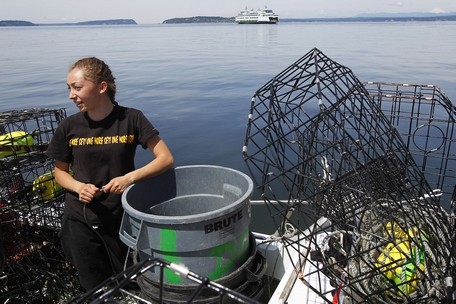
Shaylene Jefferson, 16, of Suquamish, waits in the boat for her uncle, in Mukilteo, after a day of crabbing in Puget Sound on June 11.
By Gale Fiege, The Herald
It was a summertime spot.
The Coast Salish people gave it a name that sounds much like Mukilteo.
It means “good camping ground,” said Michelle Myles of the Tulalip Tribes Lushootseed language department.
Mukilteo was the gathering place where in 1855 territorial Gov. Isaac Stevens signed the Point Elliott treaty with representatives of 22 tribes and bands of native people from the greater Puget Sound region, now called the Salish Sea.
History is big in Mukilteo, which was the first non-Indian settlement in Snohomish County. It was established about 1860 with a trading post. A fish cannery and sawmill followed later.
Mukilteo is still all about summer.
A walk-on ferry ride to Whidbey Island, beachcombing and picnic, a tour of the lighthouse, a beer at Diamond Knot, fish and chips at Ivar’s and produce from the Wednesday afternoon farmers market in Lighthouse Park off Front Street.
It’s all there in old Mukilteo. You can easily spend a full day enjoying it, so plan accordingly.
Any tour of Mukilteo has to start with its lighthouse, which opened in 1906 to guide ships in and out of Puget Sound and continues to be the city’s most enduring icon.
The Mukilteo Light Station, surrounded by native Nootka roses, is on the National Register of Historic Places. From noon to 5 p.m. on weekends you can climb the 38-foot tall lighthouse tower to see the now-automated carved-glass Fresnel lens and take a look around.
The 17-acre park along the beach has improved greatly since the city took it over from the state in 2003. Be sure to check out the park’s Coast Salish artwork created by Joe Gobin and James Madison of the Tulalip Tribes.
Kids have plenty to do, on the beach or on the playground. Educational signs help people understand what’s in the water and how to help keep it clean.
Even on a rainy day at the park, you can picnic under a shelter and enjoy the calming water-island-mountain view that seems incongruous with the fact that just a few miles away is a huge regional metropolitan area.
Mukilteo was incorporated in 1947 with a population of 775. Land annexations and development off the Mukilteo Speedway have increased that number to about 21,000 residents.
After the lighthouse, the beach park and a round-trip ride on the ferry, take in lunch at the Diamond Knot Brewery on the west side of the ferry or at Ivar’s Mukilteo Landing restaurant on the other side. You also can walk a block or so up the hill to Arnie’s seafood restaurant.
Another option is the Red Cup, located in a delightful little shopping block at Fourth Street and Lincoln Avenue across the street from the Rosehill Community Center.
The coffee shop offers breakfast and lunch, served up with a beautiful view. And from 6 to 8 p.m. on Wednesdays throughout the summer, Red Cup Cafe hosts an open microphone that attracts an eclectic mix of performers.
It’s no wonder that Mukilteo’s Rosehill Community Center is the site of dozens of weddings throughout the summer. The views are outstanding and the grounds include wild roses and other native and drought-resistant plants.
Inside, check out the display of work by local artists, the historical photos of the former Rosehill schools and Crown Lumber’s mill.
History buffs also may want to stop by the Pioneer Cemetery at Fifth and Webster streets overlooking the beach and the Japanese Memorial at Centennial Park, located at 1126 Fifth St.
The beautiful little cemetery includes a great view and the weathered gravestones of town founders Morris Frost and J.D. Fowler, along with headstones of Japanese mill workers.
The memorial is a bronze sculpture of a Japanese origami bird that sits on a white pedestal, symbolizing peace and commemorating Mukilteo’s long history with its Japanese community.
Finish your visit with a walk on the trail at nearby Japanese Gulch, a 144-acre forested park where the families of Japanese immigrants lived.
